Players 2–6 Setup time 5–15 minutes | Age range 8+ Random chance medium-dice, cards | |
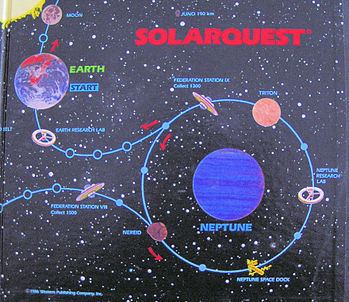 | ||
Playing time Skill(s) required Simple mathematics, such as counting, finding percentages and multiplication; Tactics; Strategy; Social skills; and Negotiation | ||
Solarquest board game vintage
SolarQuest is a space-age real estate trading board game published in 1985 and developed by Valen Brost, after his having conceived the idea in 1976. The game is patterned after Monopoly but replaces pewter tokens with rocketships and hotels with metallic fuel stations. Players travel around the sun acquiring planet, moon, and man-made space structure monopolies while fending off attacks. They seek to knock their opponents out of the game through bankruptcy, as well as optional laser blasts and dwindling fuel supplies (when using the Advanced Play ruleset).
Contents
- Solarquest board game vintage
- Solarquest
- Mission
- Game board
- Color groups
- Fuel
- Laser battles
- Basic Solarquest
- Strategic Solarquest
- Comparison with Monopoly
- 1985 and 1987 editions
- Major Competition
- Apollo 13 edition
- Spaceopoly
- Computerized versions
- References
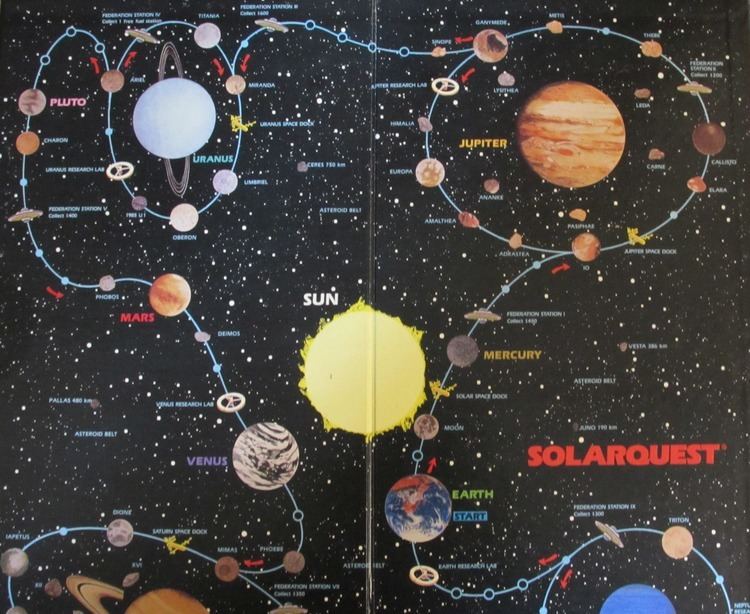
This board game is renowned for its playability and appealing design, and it developed a devoted fan base (as evidenced in the comment sections of auction sites, Amazon, and board game-related websites). Remembered fondly over decades, SolarQuest has attracted a renewed following in recent years due to its availability on eBay and other auction sites.
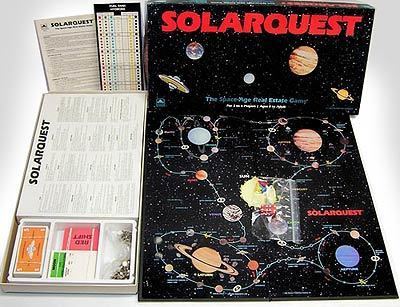
Valen ran a successful Kickstarter campaign (Nov. 8 - Dec. 25, 2016) to fund his new release of SolarQuest, expected to enter production in 2017. This "Deluxe Edition" will include more up-to-date astronomical data, a magnetic Fuel Tank Card (preventing the accidental movement of its metal markers), vibrantly modernized graphics, and enhanced gameplay.
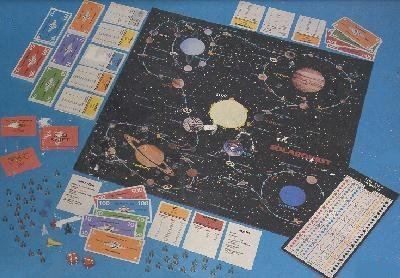
Solarquest
Mission
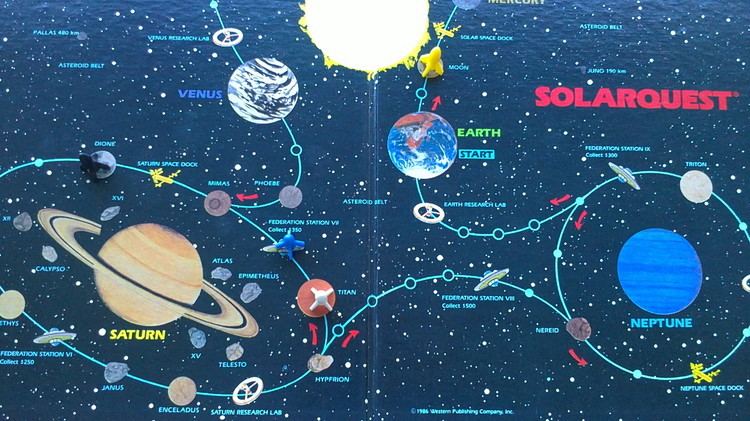
Players travel through the solar system acquiring properties, charging rent, and building fuel stations within individual planetary systems. The player who builds the greatest financial empire and survives the perils of space travel to become the last player on the board wins the game, according to the 1986 SolarQuest rules.
Game board
A journey around the Sun encompasses:
Players roll dice and travel along a blue flight path from planet to planet. There are also Red Shift cards directing players to specific destinations (e.g. Advance to Mars).
Players can buy planets and moons, and trade with one another to acquire monopolies. They can also build fuel stations on these bodies, and charge fees for refueling. Each planet has a deed card with instructions on rent and fuel costs.
Research labs and space docks are similar to the utilities in Monopoly. Federation stations cannot be owned, but offer an opportunity to collect cash and purchase spare fuel stations.
There are also 16 black dots, representing planets' gravity, and 17 blue dots, representing floating in space. Altogether, the board has a total of 91 spaces (compared to Monopoly's 40).
Color groups
The color groups are:
Fuel
Players have to watch their fuel level carefully since getting stranded with no way to refuel means the loss of the game. Fuel is only used when leaving a planet or moon. According to the rules, "This occurs because the ship must escape the gravitational pull of the planet or moon." Thus, fuel is not used when leaving a manmade satellite or an empty space.
It is always good to have spare fuel stations on hand. If a player runs out of fuel after landing on a planet that has no fuel station, he can force the sale of the property, build a fuel station, and replenish his fuel tank.
Laser battles
A suggested variation is that players who are close enough to each other can fire lasers. A roll of doubles damages the ship, allowing the aggressor to charge for repairs. A roll of double sixes completely destroys the opposing ship, knocking them out of the game.
Basic Solarquest
A Red Shift card is drawn when a player rolls doubles. These are similar to the Chance or Community Chest cards in Monopoly. The 36 Red Shift cards consist of:
Strategic Solarquest
The rules also provide for an "Advanced Play" variant known as Strategic Solarquest in which Red Shift cards are only drawn if double sixes are rolled. If another set of doubles is rolled (e.g. 1-1, 2-2, etc.) the player collects 100 federons, moves the number of spaces corresponding to the pips on the dice, and then has the option of either landing on that space or "bypassing" it and rolling again. Bypassing it means that the player does not pay rent, expend fuel when leaving the space, or do the other usual things associated with landing; instead, he continues his turn, rolling the dice and moving again from the bypassed space. Lasers can be fired when bypassing.
In Strategic Solarquest, the players' mobility is diminished because most Red Shift cards cause the player to jump around the board to a different location. This can be good or bad – good, if the player is trying to continue orbiting a planet, buying up properties; bad, if the player ends up paying high rents because he is stuck in orbit around a planet whose moons are mostly owned by another player.
Comparison with Monopoly
Solarquest is a relatively complex game, with 48 properties available for purchase (compared to Monopoly's 28), and the additional considerations of fuel and lasers. The player's path is not as linear as in Monopoly, since it is possible to continue travelling around a planet for several orbits before finally escaping its gravity. Still, the basic concepts are the same, and experience shows it is easy to learn for anyone who has played Monopoly.
Like Monopoly, this game can theoretically go on indefinitely as cash accumulates and it becomes difficult to force bankruptcy.
1985 and 1987 editions
SolarQuest was first published by Valen Brost Game Company in 1985, and then by Golden/Western Publishing Company in 1987 with minor rule revisions. For instance, in the 1985 edition, refueling on earth cost $25 per hydron; the 1987 rules provided, "If you land on Earth you may also refuel for free as a welcome home gift from the Federation." Another example is that the 1985 rules allowed the player to collect $500 for passing on Earth and $1,000 for landing on Earth; the 1987 rules provided that "Every time you land on or pass Earth you collect $500 Federons from the bank."
Major Competition
In 1994, the game and puzzle division of Western Publishing was purchased by Hasbro (parent company of Parker Brothers, the makers of Monopoly), who were then controlling 80% of the U.S. board game market, and they chose to market a Star Wars Monopoly edition instead of SolarQuest. By thus influencing retail shelf space and forcing Valen to compete using limited resources, the Monopoly brand was strengthened while SolarQuest was effectively blocked from the board game market.
Apollo 13 edition
In 1995, Universal Games released an Apollo 13 edition featuring artwork from the 1995 Universal Pictures film Apollo 13. Some differences between the 1995 edition and earlier versions include:
Spaceopoly
A highly simplified spinoff was published in 1997 by Valen Brost Game Co called Spaceopoly. This game has secret mission cards, similar to Risk, specifying an assignment that the player can complete to win the game. The rules contain quirky provisions; for example, the last sentence of the rule on laser battles reads: "If an opponent fires a laser at your ship and rolls 12 (i.e., double sixes), your ship is totally disabled and you are out of the game. Your attacker wins all of your money and property. Exception: If you hold the 'Invented a new force field' mission card you survive the attack and automatically win the game!"
Computerized versions
No computerized versions have been authorized for development by Valen Brost.
